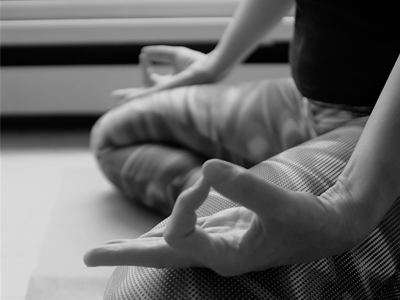A restorative yoga session usually involves a maximum of five or six poses, supported by props that allow the body to completely relax and rest. Held for 5 minutes up to 15 minutes, restorative poses include light twists, seated forward folds, and gentle backbends. The modern restorative practice was mostly designed by B.K.S. Iyengar, an Indian master from Pune, who was the first to design restorative sequences to help people struggling with injury, illness, and overwork. Now you can find restorative classes in most yoga studios.
Restorative yoga has been proven to be effective for stress relief and stress-connected conditions such as insomnia. When your life is racing full-speed ahead, so is your mind. Stress is associated with over activation of the sympathetic nervous system (SNS), the part of the autonomic nervous system that responds to fight, flight, freeze reactions when the organism encounters a threat to its survival. When someone cuts you off on the motorway or your boss yells at you, the sympathetic nervous system is activated: mouth gets dry, breathing increases, heart races, digestion stops and blood sugar rises. The SNS has a very useful evolutionary function as it ensured our survival over generations. But today, we tend to live in a culture that prizes excitement, high stress work life, high pace and general intensity that is fueled by the SNS. The problem is that chronic SNS activation associated with our fast paced lifestyles causes wear and tear in the body increasing the risk of gastrointestinal ailments such as ulcers, colitis and constipation, weakening the body immune defenses, increasing the risk of type 2 diabetes, and cardiovascular ailments such as heart attacks. Restorative yoga is a powerful healing practice, a necessary counterpoint to our busy active lives.
Consciously resting offers the body an opportunity to renew and heal by stimulating the parasympathetic nervous system (PNS), the body’s natural relaxation response. The PNS handles disengagement from the external environment, recovery from stressful experiences, and returning the body back to balance. The parasympathetic nervous system helps one to “rest and digest”. Conscious attention to the parasympathetic system brings the body back to center. Restorative yoga helps provide that physical and mental balance to prevent stress and anxiety, through the use of props that allow you to hold poses longer, giving all the benefits of deep, passive stretching.
Restorative yoga has also been proven to help with weight loss. A 2013 study from the University of California, San Diego, showed that restorative yoga helps overweight women trim fat. The study compared restorative yoga with a more active stretching regime over 48 weeks, and found that women practicing restorative yoga lost more subcutaneous fat. One explanation may be that restorative yoga reduces cortisol levels— known as a stress hormone. Yoga has long been shown to decrease cortisol, which, in elevated levels, is associated with weight gain as well as high blood pressure, and heart disease.
During winter time restorative practice is highly recommended. Indeed, when days become shorter and colder, most mammals hibernate or just physically move more slowly through the winter. But humans don’t. For us, life only gets more frenetic when temperatures drop and Christmas season arrives. In our western hyper productive culture we tend to forget about recovery time. This is why we do need rest, especially during the cold season. Restorative practice allows the body to recover fully from all the stresses and strains of life, by relaxing muscles, lowering heart rate, allowing the SNS to stop constantly reacting. The slower pace and deep breathing in a restorative yoga class triggers the parasympathetic nervous system from the very first pose. This activation helps to mitigate the effects of the regular SNS response that can be damaging to the body and personal well-being. The overall calming effect on the nervous system sets a deeply relaxing tone that comforts mind and body down to the cellular level. People come away from a restorative yoga class not only more relaxed but also more focused and effective.



